
How to Make Croissants
This a complete guide to making your first Homemade Croissants. With step by step photos, and guided instructions, this will walk you through and help you how to make the beautiful, buttery pastry.
Servings 20
Calories 235kcal
Cost $10
Equipment
Ingredients
- 1 ¼ cup warm milk heated to 105-115 ℉
- 1 tbsp. active dry yeast
- ¼ cup brown sugar
- 3 ¾ cup all-purpose flour weighed or scooped and levelled
- ½ tbsp salt
- 1 ½ cup cold unsalted butter cut into cubes
- 1 ½ tbsp all purpose flour
For the Egg Wash
- 1 large egg
- 1 tbsp milk
Instructions
Make the Dough
- In the bowl of a stand mixer, combine warm milk, yeast and the brown sugar. Let this sit for about 5 minutes, until the mixture is thick and foamy.
- Combine 3 ¾ cup of flour and salt. Attach the dough hook to the mixer. Gradually add the flour mixture in three additions to the yeast mixture, beating at low speed after each addition, then speeding up to fully incorporate the flour. At this point, if the dough is separating into long, dry and powdery chunks, drizzle about 1-2 tbsp of milk, then mix until the dough comes together. If your dough is coming together well, there is no need to add extra milk.
- Continue to run the mixer until the dough is smooth and cleans the sides of the bowl. Turn the dough over into a clean surface, and knead briefly. Pat it into a 1 ½ inch thick rectangle. Wrap it in plastic film and chill for 1 hour.
Make the Butter Block
- In the bowl of a stand mixer fitted with the paddle attachment, combine the cubed butter and 1 ½ tbsp all-purpose flour. Beat the mixture until it is smooth and incorporated. The butter may still be in chunks, but the flour should have been fully incorporated into it.
- Turn the mixture into a large plastic film. Wrap the butter and gently pat and mold it into a 5 inches rectangle that is about 1 inch thick. Make sure to press and pat the butter so that no air pockets remain. Chill this in the fridge until the dough is ready.
Enclose the Butter
- On a floured surface, roll out the dough into a 17x 10 inches rectangle. Unwrap the butter and position it at the center of this rectangle dough. The short edge of the butter should be parallel to the long edge of the dough.
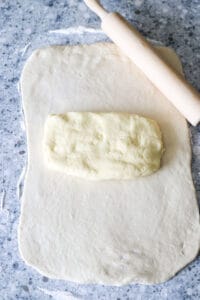
- Fold the lower flap of the dough upward to cover the butter.
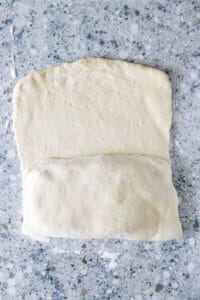
- Fold the upper flap downward to cover the first flap. The butter is now enclosed in the dough. If the dough has gotten warm, wrap it in plastic film and place it in a baking pan. Pop it in the fridge for 1 hour, if not, move on to the next step.
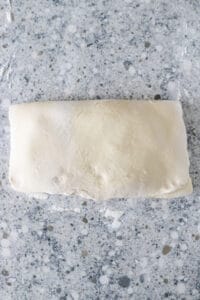
The First Fold
- On a floured surface, position the rectangle dough so that the short edge is closest to you. Using a rolling pin, gently pound the dough along its length to gently flatten the butter block inside. Roll it out into 17 x 10 inches rectangle, keeping the edges straight as best as you can.
- Fold the lower flap of the dough towards the center.
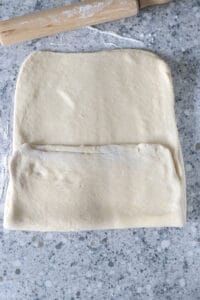
- Fold the upper flap over the center to cover the first flap. This is now now your first fold.
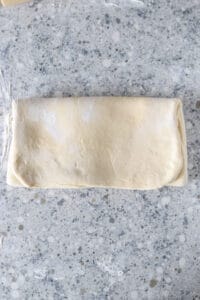
- Brush any excess flour from the dough. Wrap this in plastic film and place in a baking pan. Cover it with a clean kitchen towel. Chill it in the fridge for 1 hour or in the freezer for 30 minutes.
Repeat the Rolling and Folding 3 More Times
- So after the dough has chilled, position it in the surface so that the short edge is closes to you. Roll it out again into a 17x 10 inches rectangle. Each time you roll out the dough, make sure the surface is dusted with flour, as well as the top of the dough to prevent any sticking.
- Again, fold the lower flap over to the center, then fold the upper flap over to cover the first flap. This is your second fold. Brush any excess flour. Wrap this again in the same manner as before. Chill in the fridge for 1 hour or in the freezer for 30 minutes.
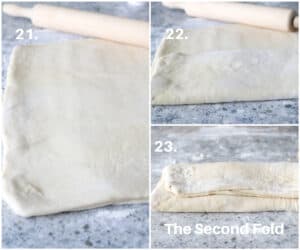
- Take out from the freezer and repeat the roll out and fold to make your Third Fold. Brush any excess flour. Wrap again and Chill.
- Next, take out the dough from the fridge. Roll it out again. This time you will see that the dough is starting to have some cracks. This is normal. If you encounter one, simply patch the area with some dusting of flour. It is also important that the surface is floured to prevent any sticking. Fold the dough in the same manner. This is your Fourth Fold. If the dough as gotten warm at this point, pop it again the fridge for 30 minutes. If not, go ahead and continue to the next step.
The Double Fold and the Long Chill.
- Roll out the dough into a 20x10 inches rectangle. Then, with the long edge closest to you, fold the two sides so that the two short edges meet at the center. Fold the entire thing in half so that the opening is to the right, like a book. Wrap the dough again and chill it the fridge for at least 8 hours, but not more than 18 hours.
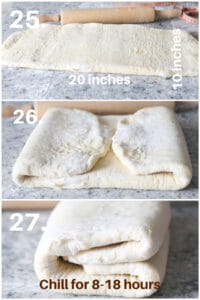
Shaping the Croissants
- After the long chill, let the dough rest at room temp for about 5 minutes. On a floured surface, roll it out into a 12x 24 inches rectangle. To do this easily, first roll out the dough as long as it is easy to do so. Once it starts to resists and it seems like its getting harder to roll it out, this means the dough needs to rest. Leave it alone for 5 minutes or so. When you come back to roll it out, you will see that it is more pliable and cooperative.
- Once you have the rectangle. Cut it in half vertically using a pizza cutter or a sharp knife. You will end up with two long rectangles.

- Cut triangles from the two rectangles, producing 10 from each side. Note that the triangles that you cut from the corners of the rectangle will look a bit different than the others. You can choose to scrap it or keep it. But really, who is gonna want to discard 4 pieces of croissants?
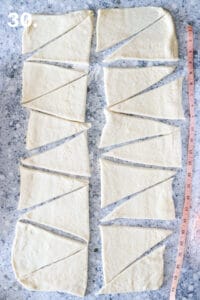
- To shape a croissant, first cut a small slit at the shortest base of the triangle using a knife. Then, gently stretch out the triangle by holding the triangle on the slit side, then pulling it out gently on the other side. Do this gently or you will tear the dough.
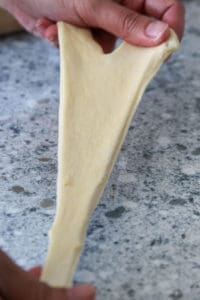
- Lay the triangle back to the surface. Starting on the slit side, roll the triangle forward until you reach the end. Make sure the pointy tip of the triangle is tucked underneath and the two sides are bent inwards to make a half moon shape.
Final Rest and Bake
- Arrange the shaped croissants into two large baking sheets that is lined with parchment paper, 10 on each pan and evenly spaced. Cover this with a clean towel and let sit at room temperature for 1 hour. Then transfer to the fridge for another hour.
- Preheat oven to 400 ℉. Beat together 1 egg and 1 tbsp. of milk. Brush the surface of the croissants with this egg wash mixture. Bake the croissants for 22-25 minutes, rotating the pan halfway into the baking time. The croissant will be golden on top. Let the croissant cool slightly and enjooooy!
- Tip: Keep the other baking pan in the fridge while you bake the first pan of croissants.
Notes
- You can freeze the dough at any point after every fold. To continue, thaw the dough in the fridge and then carry on with the instructions.
- Make sure the surface for rolling is adequately dusted with flour to prevent sticking. It helps to lightly dust the top of the dough too during rolling.
- Between second and fourth fold, you may see the dough is starting to have some cracks or peeling, This is normal because the yeast is doing it's work. To fix this, simply patch the teared area with flour.
- Brush any excess flour in the dough before folding and chilling.
- If anytime during rolling you feel the dough is retracting or getting harder to roll, simply leave it alone for about 5 minutes to let it rest. Once it is rested, it will be easier to roll it out. If it is too hot here you are, allow the dough to rest in the fridge, covered well.
- If at anytime during rolling, the dough starts to feel warm (this happens when you live in a warmer climate country, or during the summertime, or when you take too lone rolling), wrap it in plastic film and give it a quick chill in the freezer for 10-15 minutes.
- This recipe is a combination of strategies, recipes and techniques from Epicurious Croissant Recipe, Croissant dough from the book Baking with Julia by Dorie Greenspan and How to Make Croissants by Sallys Baking Addiction
Nutrition
Serving: 1piece | Calories: 235kcal | Carbohydrates: 22g | Protein: 4g | Fat: 15g | Saturated Fat: 9g | Polyunsaturated Fat: 1g | Monounsaturated Fat: 4g | Trans Fat: 1g | Cholesterol: 48mg | Sodium: 362mg | Potassium: 68mg | Fiber: 1g | Sugar: 4g | Vitamin A: 465IU | Vitamin C: 0.002mg | Calcium: 31mg | Iron: 1mg